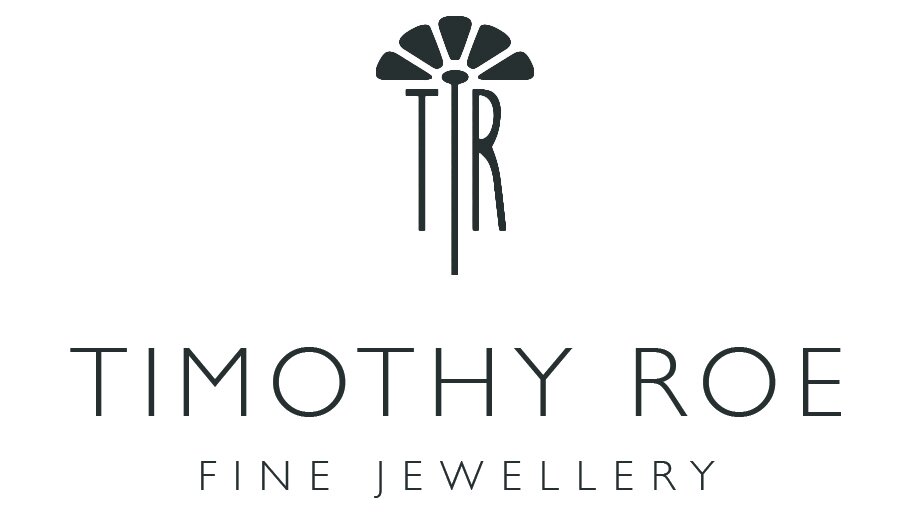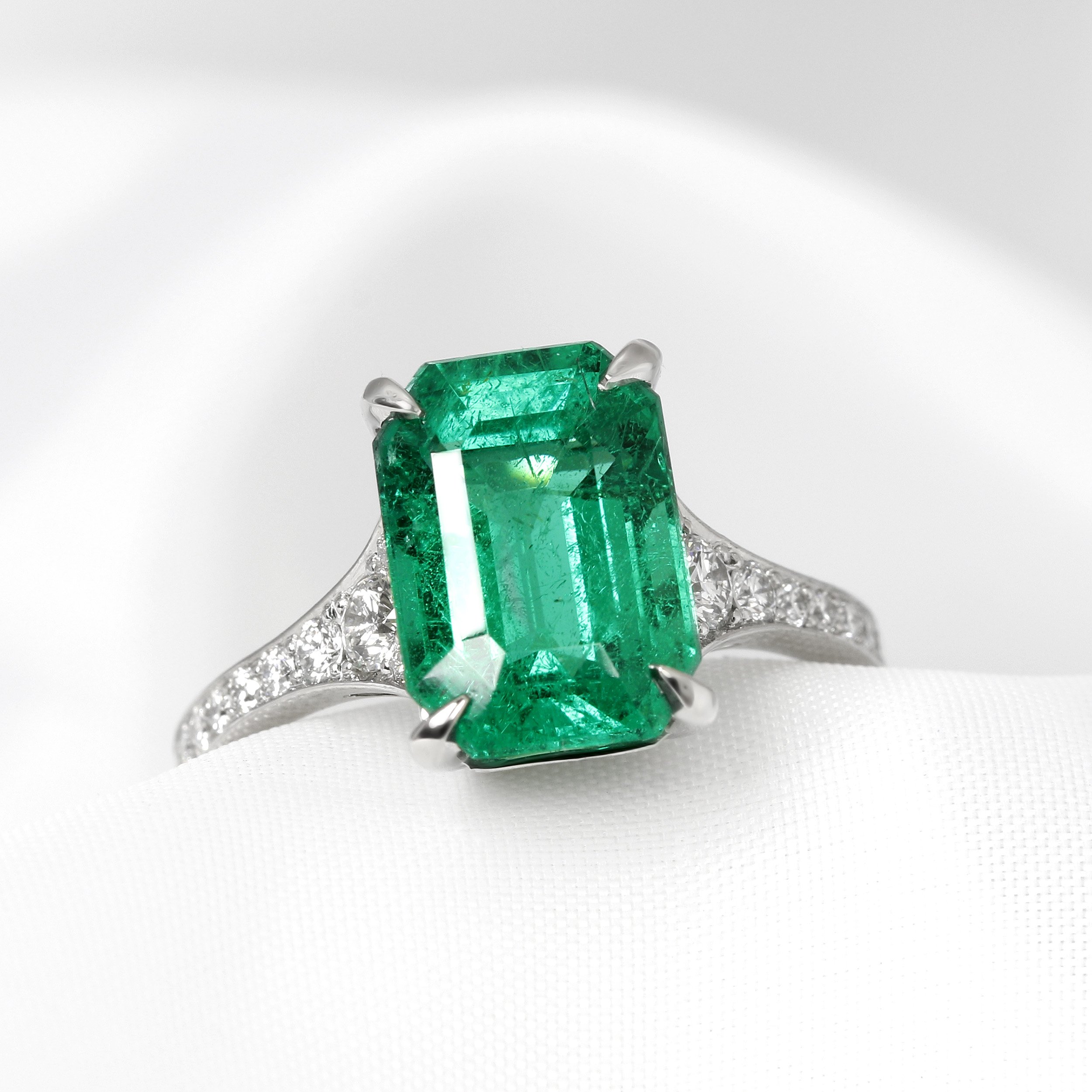All About Emeralds
Emeralds: The Green Jewel of Timeless Elegance
When it comes to coloured gemstones, few possess the mystique and magnetism of the emerald. With its rich green hue and centuries of regal heritage, this captivating gem has long been a favourite in the world of fine jewellery—and it’s not hard to see why. When customers see our green gems they instantly think it is an emerald—there are many other green gems: tsavorite garnets, tourmalines and green sapphires, but due to emerald’s prestigious status when we see a green gem our instinct is to see it is an emerald.
What Makes an Emerald So Unique?
Emeralds belong to the beryl family of minerals and owe their lush green tones to trace amounts of chromium and vanadium. But their formation is far from ordinary. Emeralds crystallise under extremely rare geological conditions, requiring the unusual coexistence of elements such as beryllium and chromium—two components that rarely occur together in the Earth’s crust. This geological rarity is one of the key reasons emeralds are so prized.
Most emeralds are found in metamorphic and hydrothermal deposits. They naturally grow in hexagonal prism formations and display a glassy, vitreous lustre both in their rough state and as polished gemstones.
Fun fact: Some emeralds fluoresce pink or red under UV light due to the presence of chromium!
Unlike many other gemstones, emeralds almost always contain inclusions and these are features we want to see! These internal features are fissures, looking like little veins or vines throughout the stone and often affectionately referred to as jardin—French for “garden”—as they can resemble delicate, plant-like patterns. Far from being flaws, these inclusions are celebrated by jewellers and collectors as natural signatures of the stone’s origin.
Location and Colour
Emeralds have been treasured for millennia. The earliest known mines were in Egypt, operating from around 330 BC well into the 1700s. Cleopatra herself was famously enamoured with emeralds and incorporated them into her royal adornments. The stones have long been symbols of power, renewal, and romance.
After the decline of the Egyptian sources, it was Colombian emeralds—discovered during the 16th-century Spanish conquest—that rose to global prominence. Today, Colombia remains the most revered source of high-quality emeralds, particularly those with deep colour saturation and excellent transparency.
Colombian emeralds are often characterised by fascinating inclusions such as gas bubbles, crystals, liquids, and distinctive fissures.
However, Colombia is far from the only producer:
Zambia – Known for rich greens with subtle bluish undertones.
India – Often shows gas and liquid inclusions from its formation history.
Brazil – Typically lighter in tone with cleaner clarity.
Siberia – May contain fine, needle-like actinolite inclusions.
Zimbabwe – Notable for fibrous tremolite inclusions.
Pakistan, South Africa, and Afghanistan – Produce emeralds with unique features like colour zoning, mica flakes, pyrite, and calcite inclusions.
Each source offers something distinct, adding character and provenance to the gemstone and an array of green hues and shades from light green, bright vivid green, rich blue-green, sea-green to darker earthy yellowy-grass green. Depending on the concentration of the colouring elements and the other minerals in its chemical composition will determine the shade and saturation of the gems.
Enhancing Emerald Beauty: A Note on Treatments
Due to their natural brittleness and the presence of surface-reaching fissures, most emeralds undergo clarity enhancement treatments. It’s standard industry practice to fill these fissures with substances such as oil, wax, or synthetic resin to improve the stone’s visual appearance.
However, not all fillers are created equal:
Cedar wood oil, a traditional filler, is preferred in many markets for its subtlety and reversibility and stones filled with cedar wood will command higher prices on the markets.
Synthetic resins may enhance clarity more significantly and are more durable, but they’re also harder to remove and may affect long-term value.
Occasionally, dyes are added to these fillers to intensify colour—something that must always be disclosed.
Identifying these treatments can be challenging, even for experts. As such, it's prudent to assume that most commercial emeralds have been treated unless otherwise confirmed.
The type and extent of treatment significantly influence the stone’s appearance, durability, and market price.
Emeralds in Contemporary Fine Jewellery
Today, emeralds feature prominently in high jewellery collections for their dramatic, vivid colour and timeless appeal. Their deep green contrasts beautifully with white diamonds and platinum, while also offering a lush warmth when set in yellow gold.
While diamonds and sapphires still dominate engagement ring preferences, emeralds are increasingly chosen by those seeking individuality and romantic distinction for special occasions. Their rarity, historical prestige, and expressive colour make them ideal for bespoke and statement pieces.
Choosing the Right Emerald
If you’re considering owning an emerald, here are the key qualities to evaluate:
Colour – The most important factor. Look for a rich, vibrant green with even saturation and minimal zoning but let the shade speak to you. Everyone likes different hues of green so go for what catches your eye and makes you happy.
Clarity – Inclusions are expected, but avoid stones with deep fractures that could impact durability and ask about treatments.
Cut – The emerald cut (an octagonal shape with stepped facets and truncated corners) is both elegant and functional. It enhances colour while protecting the stone’s most vulnerable points. It is the classic shape but round cuts are also popular.
Carat Weight – Larger emeralds of fine quality are particularly rare and command premium prices. Most coloured stones need to be cut slightly deeper to retain the colour so check the proportions of the stone rather than go by carat weight. Remember, emeralds weigh less than diamonds.
Always ask your jeweller about caring for emeralds and after-care services like re-oiling.
Caring for Your Emerald
While emeralds rate around 7.5 on the Mohs scale, they are inherently brittle due to their fissures. Proper care is essential to maintain their beauty:
Avoid impact. Emeralds can chip or fracture with a sharp knock.
Keep them away from heat, chemicals, and ultrasonic cleaners. These can damage the stone or cause fillers to evaporate or discolour.
Clean gently. Use lukewarm soapy water and a soft brush or cloth—never soak emeralds for extended periods.
Store separately. Protect them from harder gemstones that may scratch the surface.
Consider having your emeralds refilled (re-oiled) every few years to maintain their appearance and to avoid them drying out and becoming even more brittle.
With mindful handling, your emerald can remain radiant for generations.
More Than Just a Pretty Stone: Lore and Culture
Emeralds are more than a symbol of beauty—they’re steeped in legend and cultural richness. Long associated with rebirth, wisdom, and enduring love, emeralds are the birthstone for May and the traditional gift for 20th and 35th wedding anniversaries.
In The Book of Talismans (1914), emeralds are said to “strengthen the memory and protect from giddiness” when worn in a ring. Sailors once believed that wearing an emerald on their chest could protect them from perils at sea.
Final Thoughts
An emerald is never just a green stone. It is a marvel of nature—formed under rare conditions, steeped in history, and celebrated across cultures. Whether you're selecting an heirloom-quality piece or designing a bespoke creation, emeralds offer a mesmerising blend of rarity, elegance, and storytelling.
If you’re investing in an emerald, ask the right questions. Know its origin, understand the treatments and enhancements, and choose a jeweller who values transparency. When you do, you’ll gain more than a gemstone—you’ll acquire a timeless treasure with a story all its own.
Find Your Perfect Emerald Piece
At Timothy Roe, we create stunning, one-of-a-kind emerald pieces, including rings, earrings, pendants, and more. Each design is brought to life in our Chichester workshop, where exceptional craftsmanship meets a deep appreciation for this remarkable stone. For those with a particular vision, we also offer a bespoke service – ideal for crafting a emerald ring or meaningful gift that’s entirely your own. Whether you're choosing from our collection or creating something bespoke, every piece of emerald jewellery from Timothy Roe is made with passion, care, and expertise.










